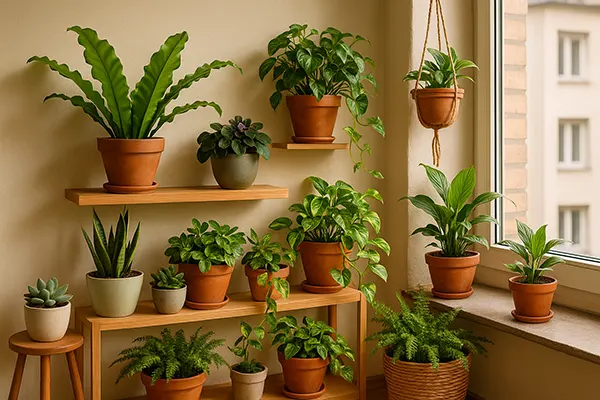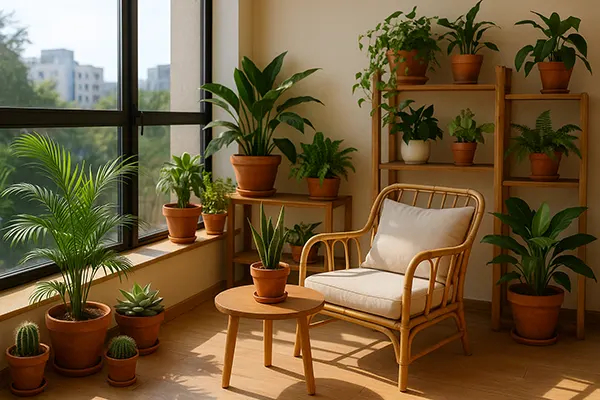
Living in a city often means limited access to nature, yet more people are discovering ways to bring greenery into their homes. A mini garden inside a flat is not only an aesthetic solution but also a source of relaxation, mindfulness, and improved air quality. By choosing the right plants and arranging them thoughtfully, even the smallest living space can be transformed into a calming sanctuary where daily stress gently fades away.
Choosing the Right Plants for Your Mini Garden
When planning a mini garden at home, selecting suitable plants is the first step. Beginners may find it easier to start with hardy and low-maintenance varieties. Succulents and cacti, for instance, require little watering and thrive in bright, sunny windows. Ferns, on the other hand, enjoy shaded areas and add a refreshing, lush touch to any corner.
Indoor-friendly plants such as snake plants or peace lilies are popular because they tolerate changing conditions well and contribute to air purification. Small flowering plants like African violets can also add colour without demanding too much attention. The key is to choose greenery that fits both your lifestyle and the environment of your flat.
It is important to remember that plants with different needs should not always be grouped together. A successful mini garden balances aesthetics with practicality, ensuring that each plant thrives in its chosen spot.
Arranging and Styling Your Green Corner
Once you have selected your plants, arranging them in a visually appealing and functional way is the next step. Vertical shelves or hanging baskets are excellent for saving space, especially in smaller rooms. Grouping plants of different heights and textures can create a layered effect that makes the space look natural and vibrant.
Consider using decorative pots, recycled jars, or ceramic bowls to add a personal touch. Matching the design of containers to your interior style enhances the sense of harmony and makes the garden part of the overall décor. Simple additions such as pebbles, driftwood, or small figurines can bring character to your green corner.
Lighting also plays a role in styling. Positioning plants near windows or supplementing with LED grow lights helps ensure they receive adequate brightness. This makes the garden not only decorative but also sustainable in the long term.
Practical Care Tips for Indoor Plants
Maintaining a mini garden is easier than it might seem, but consistency is key. Watering should always be adapted to the needs of each plant type. Overwatering is one of the most common mistakes and often leads to root rot. Succulents, for example, require far less water than ferns or peace lilies.
Lighting conditions must also be taken into account. Some plants thrive in direct sunlight, while others prefer indirect or diffused light. Checking the requirements of each plant ensures they grow healthily and maintain their vibrant appearance. Adding natural or artificial humidifiers can be helpful in dry indoor environments.
Fertilising once every few weeks during the growing season provides additional nutrients and encourages stronger growth. Using organic or balanced fertilisers helps keep the mini garden healthy without overwhelming delicate plants. Regular dusting of leaves also improves photosynthesis and gives the greenery a fresh look.
Common Mistakes and How to Avoid Them
New plant owners sometimes overlook the importance of moderation. Overwatering, overfertilising, or moving plants around too often can stress them. Establishing a steady routine based on observation is usually the best approach. Learning to check soil moisture before watering prevents unnecessary damage.
Another common mistake is choosing plants unsuited to the indoor environment. For example, tropical species requiring constant humidity may not adapt well to dry flats. Researching the basic needs of each plant before purchase can save time and frustration later.
Finally, neglecting regular maintenance such as trimming dead leaves or repotting when necessary can hinder growth. With a little patience and consistency, these small tasks become part of a calming ritual rather than a chore.

The Psychological Benefits of a Home Mini Garden
Studies conducted in recent years have shown that surrounding oneself with greenery can reduce stress levels, improve concentration, and even support better sleep. Having a mini garden inside the flat provides a personal retreat from busy urban life and encourages mindful moments of care and observation.
Indoor plants create a more inviting atmosphere, making the home a pleasant place to spend time. Their presence can improve mood, ease anxiety, and foster a sense of connection to nature. This is particularly valuable for people who live in high-rise buildings with limited access to outdoor greenery.
Psychologists highlight that engaging in plant care helps develop patience and focus. The small routines of watering, pruning, and arranging plants can act as a form of active meditation, supporting mental health in a simple but effective way.
DIY Ideas for Creating Your Own Mini Garden
Creating a mini garden does not require expensive tools or professional skills. Old glass jars can be transformed into terrariums with a mix of soil, stones, and small succulents. Wooden boxes or unused kitchen bowls can be repurposed into charming plant containers, adding a sustainable touch to the home.
For those with limited space, wall-mounted racks or frames with potted herbs provide both a decorative and practical solution. Fresh herbs such as basil, mint, or parsley not only bring greenery but also add flavour to everyday cooking.
Adding personal details, such as handmade plant markers or recycled decorations, makes the mini garden truly unique. Combining creativity with greenery ensures that each corner reflects individual style while providing a calming place to relax and recharge.